THE SYNTAX OF THE DOUBLE-DISC/Z
In which I discover a late radical change in the syntax of the double-disc/Z
Occasionally, something cracks open, and it’s more stunning than I could ever imagine! That’s what has just happened, after years of looking at Pictish symbols, thinking that the Class II Christian symbols simply disregarded the rules of syntax, or had lost the knowledge of them, I finally realised that this was not the case, that something quite deliberate was happening. And the implications of that are enormous.
So here is the story of the syntax of the double-disc symbol, sometimes with a Z rod, sometimes without. And what happens to it during the Class II period. (Note, this isn’t about its meaning, just its syntax.)
The double-disc/Z is the bottom symbol in the ordered list (as far as I can tell). And it is the second most common symbol, with a good body of data to work with. Which makes it an ideal symbol to take a closer look at, as its bottom position in the list limits its possible configurations.
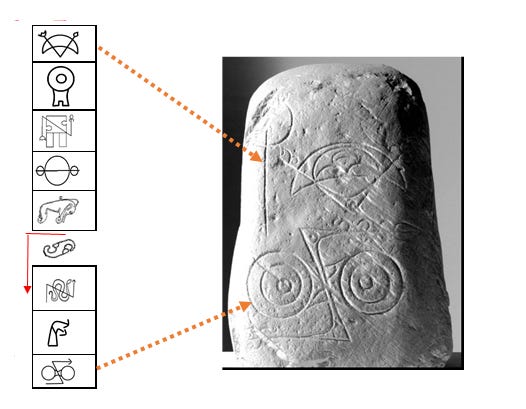
To recap, here is a diagram of the three main types of configuration I’ve previously discussed, using the double-disc/Z (FIG 2). I’ve used the crescent/V as an example of an accompanying symbol, but this could be replaced by any other symbol, as all of the other symbols are higher in the list than the double-disc symbol. The symbol which has precedence in each case is in a yellow box.
The three different configurations will be referred to here as a) normal b) mirror and c) mirror+comb.
For ease of reference, symbol stones have traditionally been divided into classes. Class I (CI) symbol stones start earlier, with only symbols on them. The later Class II (CII) stones are usually identified by having a Christian cross and other non-symbol icons on the same stone. While this classification of stones is useful, it is broad and general. It is not known if, or for how long, or where, CI-type of symbol stones kept being carved into the same period when CII stones with a cross were also being made.
The Class I double-disc/Z
I’ll start by looking at the situation with the Class I double-disc /Z symbols, where we see these three configurations used by all stones where the full configuration can still be seen (FIG 3). The only example of a stone with a double-disc/Z and an incorrect reverse syntax is Keith Hall. (This stone is of particular interest and I’ll eventually come back to it.)
The Class I double-discZ distribution has a strong focus in the area from Aberdeen up to Rhynie and Clatt.
Most examples are right-hand (red and blue), but there is an odd group of LH symbols (yellow) at Rhynie-Clatt. There is also one LH example at Aberlemno, one at Edderton, and one at Tote in Skye. It may be of significance that these LH examples occur at high status sites.
The double-disc/Z symbol does not occur in the north, with Edderton in Easter Ross the most northerly example. (Despite this there are two double-disc/Z symbols on painted pebbles in Shetland. One, found at Jarlshof, is simply incised, just an outline of the symbol. The other, from Eswick, is more elaborate - one disc has an incised X, the other a central dot, and according to Anna Ritchie the Z-rod is reversed. Thanks to Linda Sutherland for this information).
The configurations of the Class I double-disc/Z
Next, let’s look at what configurations are used (FIG 4). Most examples are of the ‘normal’ configuration (red dots), that is, just two symbols in the same relative order as they occur in the ordered list without an accompanying mirror or mirror+comb (as shown in the Invereen example in FIG 1).
There are only a few examples of the double-disc/Z in the south, and all of these have a mirror+comb (navy dots).
Oddly enough, this means that most of the northern double-disc/Z symbols occur as the lower subordinate symbol, despite its concentration there, while in the south the double-disc/Z is given precedence on stones by the addition of the mirror+comb.
This importance of the double-disc+-Z in the south is also indicated by more than half a dozen examples in the Weymss caves on the southern Fife shore. These southern caves also feature several arch symbols. But they don’t feature any of the crescent+-V despite this being the most frequent symbol in the whole body of symbols. In contrast the northern Sculptors Cave on the Moray coast has no double-disc+-Z, but features the crescent+-V and the disc-over-rectangle. This suggests that these two symbols crescent/double-disc have a north/south significance, but whether that is a geographical, political, or philosophical significance, is hard to say.
The four stones in the south with a mirror+comb are Dunnichen, Aberlemno1, Aberlemno6 (LH), and Keillor. What is interesting is that the Dunnichen stone has beautiful intricate symbols, yet its mirror+comb seems to be badly carved, not in the required La Tene relationship to the size of the main symbols, as if they have been added on to the stone after the fact, or at a later date (FIG 5). Which suggests this use of the mirror+comb on all stones in the south is deliberate and has some particular significance.
Although the map shows only one certain example of a double-disc/Z with mirror+comb at Rhynie, Rhynie 5, it’s possible that Rhynie2 and Clatt1 and Clatt2 also have a mirror+comb, although these stones are too fragmentary to be sure. But again, the mirror+comb is focused on three key places, Rhynie, Aberlemno, and Tote. Both the LH examples and those with a mirror+comb feature at these key sites.
The two examples in Aberdeenshire with a mirror+comb are Keith Hall, that was noted above as having the wrong order, and Bourtie, which has a double-sided comb and intricate finely carved symbols. As we’ll see in a moment, both of these stones can be placed in the later CII period despite being CI-type of stones with just symbols.
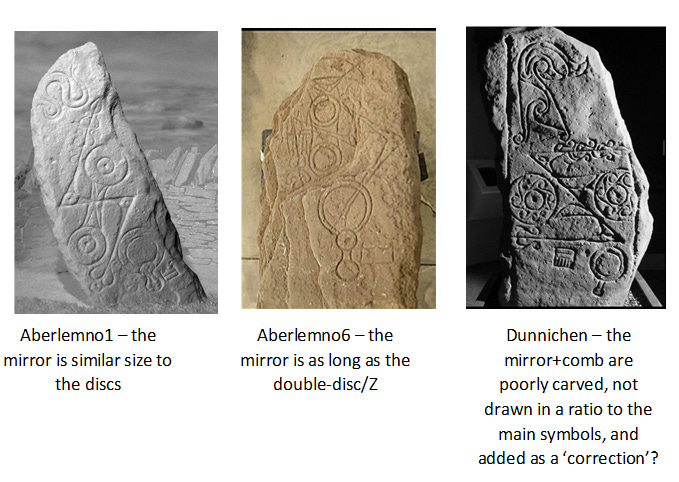
Of the 23 pairs of symbols with a RH double-disc/Z, only 4 have a mirror+comb, and 2 have a single mirror. Although the number of LH symbols is much smaller at 7, all but one has either a mirror+comb, or potentially might have (FIG 6). We will see this peculiar pattern - a few RH examples with a mirror+comb but most LH examples mostly with a mirror+comb - repeated on the CII stones.
The Class II double-disc/Z
The Class II distribution is markedly different to Class I. Although the double-disc/Z is spread widely across CII stones, it now has a concentration in the Angus region around Forfar.
The left-hand form of this symbol is only found in this Forfar region. As the LH form was found at key centres on earlier CI stones, it seems reasonable to assume the CII LH form is also following the same pattern, and that the Forfar region is now the focus of political/religious power. It is also this same Forfar region where a new form of LH symbol, with horizontal rather than vertical discs, appears – a rare event where the preferred shape of a symbol changes. (Later we will see that this group coincides with the CII group that reverses the order.)
The overall distribution still does not spread northwards past Easter Ross, except for one outlier in Mail, Shetland.
The CII double-disc/Z symbols have a distinct focus on St Vigeans in the region of Angus, where there are 4 examples. From there they spread over Angus, stopping at the concentration of the Pictish beast in Gowrie (FIG 8). This strongly suggests that the double-disc/Z symbol in the CII period may be taking on a geographical identity.
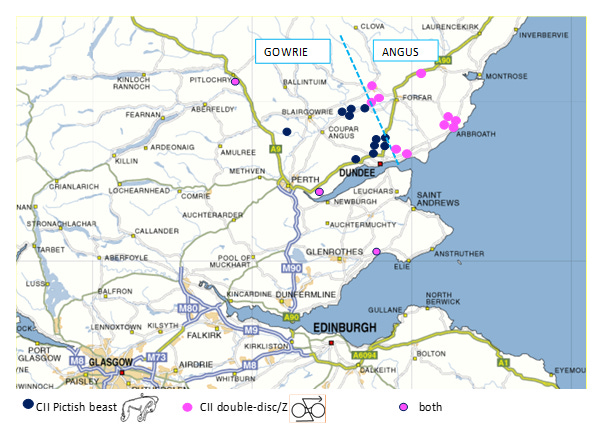
The configurations of the Class II double-disc/Z
When we look at what configurations the Class II double-disc/Z symbols are using, we begin to see quite dramatic changes.
The next map (FIG 9) shows those symbol stones that now have the wrong order, that is, the double-disc/Z is sitting above its accompanying symbol, rather than below it as dictated by the ordered list. Remember above we only had one odd example of a CI stone with the wrong order, now we have 13, possibly 14, stones with the wrong order (black stars), and only 6, possibly 7, stones still with the correct order (purple stars).
The treatment of the double-disc/Z on these 13/14 CII stones shows an extraordinary change. The double-disc/Z is the last symbol on the ordered list, and - normally - shouldn’t take precedence over any other it’s paired with. Yet now these stones are in the reverse order with the double-disc/Z as the upper symbol instead of the lower, so having precedence.
It is not necessary to use the incorrect order like this to give the double-disc/Z precedence. Under the usual rules seen on Class I stones, the double-disc/Z could be given precedence if the order is reversed and accompanied by a single mirror, although this configuration is never used on CII stones. It could also be given precedence simply by the addition of a mirror+comb. So the change to a completely different configuration on these CII stones means that using the wrong order is a deliberate act.
There are one or two other CII symbol stones with the wrong order and symbols other than the double-disc/Z, but it is here with this one symbol, the double-disc/Z, that the situation has radically changed for the group as a whole. For some reason, at this point in time, the double-disc/Z is allowed to break the rules of syntax by sitting above its accompanying symbol.
In comparison, of the 23 examples of a CII crescent/V, 7 are in the wrong order, but of these 4 are paired with the incorrect double-disc+-Z, while another 2, Ulbster and Glenferness, are on stones that also have another pair of symbols using the double-disc+-Z with the incorrect order. This leaves only one stone that has a pair of symbols that does not include the double-disc/Z in the wrong order, Meigle4, with a Pictish beast over a crescent/V.
Again in comparison, there are 23 examples of a CII Pictish beast, and 5 of them are in the incorrect order. However, again all but Meigle4 are on stones which also have a double-disc+-Z in the incorrect order.
The single symbol on its own
Something else peculiar is also happening on this group of CII double-disc/Z stones. On Class I stones there are no certain examples of a single symbol, all symbols come in a pair or a multiple of pairs. Yet there are now three known CII stones with a single double-disc/Z and no accompanying symbol, Alyth, Fordoun, and Kirriemuir2 (green dots on FIG 10).
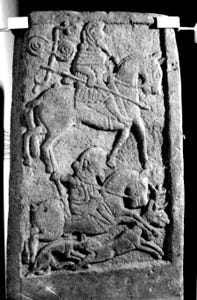
The Logierait1 stone may be another instance of the use of a single symbol, in this case the snake/Z, but the top of the stone is eroded off which may have held another symbol, so the situation isn’t absolutely certain.
It is interesting that this group of stones with a single symbol, to which we can add the Dunfallandy stone with a single Pictish beast, all lie on the upper or outer point of a region’s symbol stones.
In the case of Kirriemuir2 and Fordoun, there are male horsemen icons also on the stone, and I’ve written before of how on the Cadboll stone the double-disc/Z hidden within the border mirrors the position of the male rider hidden behind the female rider. It looks like the double-disc/Z is being associated with male icons in this final stage of CII stones.
The changing mirror+comb configuration
The next map (FIG 11) is the same distribution map of CII stones, but with those symbol stones with a mirror+comb now marked with a yellow star.
3 out of the 5 CII pairs with a LH double-disc/Z have a mirror+comb, and only one, Largo, clearly has no mirror+comb. Again, for some reason, we see the CII LH examples, like the CI LH examples, tending to attract the use of the mirror+comb, with the proviso that this is a small group.
The very presence of a mirror+comb should lead to an expectation that the correct syntax configuration is being acknowledged and followed. But this is not the case. Again, these stones are all in the wrong order to expected. But they are in the right order if we accept that the double-disc/Z is now to be used as an upper symbol. This situation can only happen if the use of the wrong order in this late CII period is a deliberate choice, rather than simply ignoring the rules.
In a way, the exceptional stones on this map of CII stones are the handful of examples (purple stars) which still retain the correct configurations – Brodie, Conan, Eassie, Cossans, and Aberlemno3. Another possible example is St Vigeans5 but it is unclear which way up this stone sits. It may be that this group of stones was carved earlier in the CII period before the radical change in order was instigated, which suggests that this change may not have occurred with the introduction of CII stones, but happened at some time into the CII period.
However, there is one stone that puts this sequential timeline in doubt, Brodie in Moray (FIG 12). This is the only CII symbol stone in Moray that has its symbols in the correct order, a Pictish beast over a double-disc/Z. Yet this stone otherwise has all the same aspects of a late CII stone from the same period as the rest of this group – a late cross without a defined centre, ogham inscriptions that mention Ethernan, symbols that are very cludgy and staid, interlace that is too open to be typical of Pictish interlace. Using symbols in the correct order on the Brodie stone must be a deliberate decision, at the same time as all the other symbol stones in Moray are using the incorrect order. From this, we can take that using the incorrect order isn’t a new idea to be applied comprehensively, but it has a specific, and new, meaning underlying it, a rationale which for some reason isn’t considered appropriate to the Brodie stone.
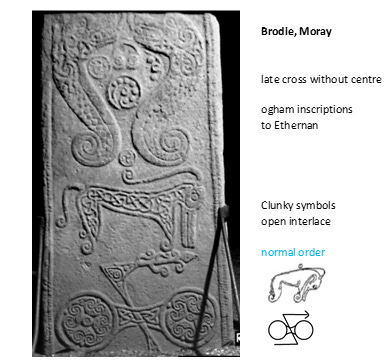
Dating the change in order
At this point, I need to break the CII period into two for ease of reference, with the proviso that there will inevitably be a stone (like Brodie) which crosses the line. An earlier period, with good symbols in the right order, which I will call the earlyCII period. And a later CII period, in which the double-disc symbol is often reversed, which I will call the lateCII period. This lateCII period also sees inscriptions and single symbols being employed and other changes still to be discussed.
It is easy to put a relative date on this change in symbol order, as happening in the later part of the Class II period. But, can we put a definite date to this period? We can say with certainty that the date of the lateCII period encompasses the 700s, as we see Shandwick and Cadboll with the new order, and these stones must have been carved before the destruction of the monastery at Portmahomack around the year 800. But how long before that period did the change start? That is a much harder question to answer.
There is one example where a double-disc/Z occurs to the left side of a sea-beast, putting it in the new CII order. This is the rock at the entrance to the fort at Trusty’s Hill in Galloway. This hillfort was only active for a few years before c.600 AD, when it was destroyed. Technically, this rock isn’t a traditional symbol stone, but it still seems to be acting as one, with a good symbol pair. If we are to accept this example as one of this late CII group, then it pushes the change in order back a fair way. Which is surprising. But then we don’t have any idea of when the CII stones as a group began to be carved, so it is possible that this dating of the change in order is correct, although on balance it seems unlikely.
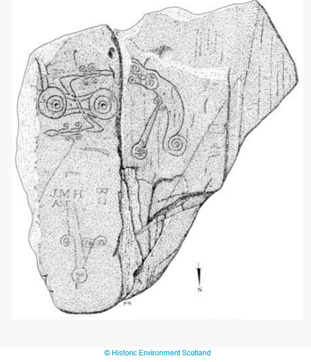
Summarising what we have so far:
The CI double-disc/Z is focused in the Aberdeenshire region, but this shifts for CII stones to the southern region of Angus.
The double-disc/Z is the bottom symbol in the order list, and so on CI stones occurs as the bottom symbol of the pair.
But on most of the CII examples, we see the double-disc/Z being placed as the upper symbol of the pair.
This changed CII order for the double-disc/Z is internally consistent for the normal configuration (Type A), and the configuration with the mirror+comb (Type C), showing that this new order is a deliberate choice.
The LH symbol of this group then changes its form to have horizontal discs rather than vertical discs, again indicating a changed perception of this one symbol.
The new LH forms only occur in the Angus region centred on Forfar, and with a special concentration at St Vigeans.
The mirror+comb does occur a few times with RH double-disc/Z symbols, but is more heavily concentrated on stones with a LH symbol, and this pattern is consistent from CI to CII stones.
The double-disc+-Z starts to occur on its own without an accompanying symbol
It is now often accompanied by male icons.
This change in order was definitely in place in the 700s, but may date back to c.600 AD.
For ease of reference, I will break the CII period into the earlyCII period where symbols are in their proper order, and the lateCII period when the double-disc/Z reverses its order, and other changes also occur.
In my next blog, I will continue to investigate this changing order for the double-disc/Z symbol, to discover what the significance of the change might mean. As well, I will add in an analysis of the double-disc when used without its rod.










